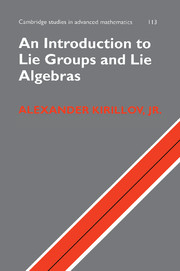Book contents
- Frontmatter
- Contents
- Preface
- 1 Introduction
- 2 Lie groups: basic definitions
- 3 Lie groups and Lie algebras
- 4 Representations of Lie groups and Lie algebras
- 5 Structure theory of Lie algebras
- 6 Complex semisimple Lie algebras
- 7 Root systems
- 8 Representations of semisimple Lie algebras
- Overview of the literature
- Appendix A Root systems and simple Lie algebras
- Appendix B Sample syllabus
- List of notation
- Bibliography
- Index
Appendix B - Sample syllabus
Published online by Cambridge University Press: 31 May 2010
- Frontmatter
- Contents
- Preface
- 1 Introduction
- 2 Lie groups: basic definitions
- 3 Lie groups and Lie algebras
- 4 Representations of Lie groups and Lie algebras
- 5 Structure theory of Lie algebras
- 6 Complex semisimple Lie algebras
- 7 Root systems
- 8 Representations of semisimple Lie algebras
- Overview of the literature
- Appendix A Root systems and simple Lie algebras
- Appendix B Sample syllabus
- List of notation
- Bibliography
- Index
Summary
In this section, we give a sample syllabus of a one-semester graduate course on Lie groups and Lie algebras based on this book. This course is designed to fit the standard schedule of US universities: 14 week semester, with two lectures a week, each lecture 1 hour and 20 minutes long.
Lecture 1: Introduction. Definition of a Lie group; C1 implies analytic. Examples: ℝn, S1, SU(2). Theorem about closed subgroup (no proof). Connected component and universal cover.
Lecture 2:G/H. Action of G on manifolds; homogeneous spaces. Action on functions, vector fields, etc. Left, right, and adjoint action. Left, right, and bi-invariant vector fields (forms, etc).
Lecture 3: Classical groups: GL, SL, SU, SO, Sp – definition. Exponential and logarithmic maps for matrix groups. Proof that classical groups are smooth; calculation of the corresponding Lie algebra and dimension. Topological information (connectedness, π1). One-parameter subgroups in a Lie group: existence and uniqueness.
Lecture 4: Lie algebra of a Lie groups:
g = T1G = right-invariant vector fields = 1-parameter subgroups.
Exponential and logarithmic maps and their properties. Morphisms f:G1 → G2 are determined by f*:g1 → g2. Example: elements Jx, Jy, Jz ∈ so(3). Definition of commutator: exey = ex+y+½[x, y]+….
Lecture 5: Properties of the commutator. Relation with the group commutator; Ad and ad. Jacobi identity. Abstract Lie algebras and morphisms.
- Type
- Chapter
- Information
- An Introduction to Lie Groups and Lie Algebras , pp. 210 - 212Publisher: Cambridge University PressPrint publication year: 2008

